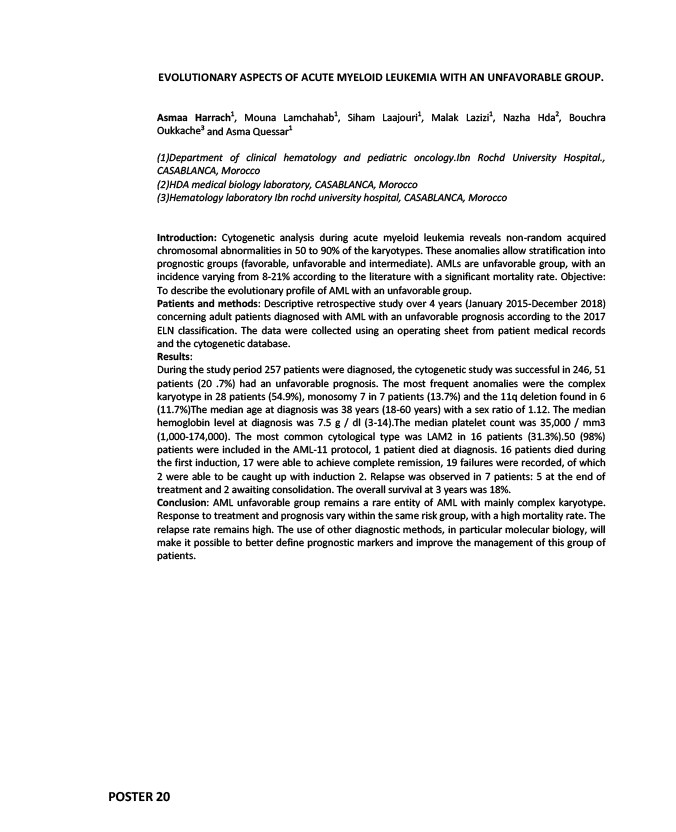
EVOLUTIONARY ASPECTS OF ACUTE MYELOID LEUKEMIA WITH AN UNFAVORABLE GROUP.
Asmaa Harrach1, Mouna Lamchahab1, Siham Laajouri1, Malak Lazizi1, Nazha Hda2, Bouchra
Oukkache3 and Asma Quessar1
(1)Department of clinical hematology and pediatric oncology.Ibn Rochd University Hospital.,
CASABLANCA, Morocco
(2)HDA medical biology laboratory, CASABLANCA, Morocco
(3)Hematology laboratory Ibn rochd university hospital, CASABLANCA, Morocco
Introduction: Cytogenetic analysis during acute myeloid leukemia reveals non-random acquired
chromosomal abnormalities in 50 to 90% of the karyotypes. These anomalies allow stratification into
prognostic groups (favorable, unfavorable and intermediate). AMLs are unfavorable group, with an
incidence varying from 8-21% according to the literature with a significant mortality rate. Objective:
To describe the evolutionary profile of AML with an unfavorable group.
Patients and methods: Descriptive retrospective study over 4 years (January 2015-December 2018)
concerning adult patients diagnosed with AML with an unfavorable prognosis according to the 2017
ELN classification. The data were collected using an operating sheet from patient medical records
and the cytogenetic database.
Results:
During the study period 257 patients were diagnosed, the cytogenetic study was successful in 246, 51
patients (20 .7%) had an unfavorable prognosis. The most frequent anomalies were the complex
karyotype in 28 patients (54.9%), monosomy 7 in 7 patients (13.7%) and the 11q deletion found in 6
(11.7%)The median age at diagnosis was 38 years (18-60 years) with a sex ratio of 1.12. The median
hemoglobin level at diagnosis was 7.5 g / dl (3-14).The median platelet count was 35,000 / mm3
(1,000-174,000). The most common cytological type was LAM2 in 16 patients (31.3%).50 (98%)
patients were included in the AML-11 protocol, 1 patient died at diagnosis. 16 patients died during
the first induction, 17 were able to achieve complete remission, 19 failures were recorded, of which
2 were able to be caught up with induction 2. Relapse was observed in 7 patients: 5 at the end of
treatment and 2 awaiting consolidation. The overall survival at 3 years was 18%.
Conclusion: AML unfavorable group remains a rare entity of AML with mainly complex karyotype.
Response to treatment and prognosis vary within the same risk group, with a high mortality rate. The
relapse rate remains high. The use of other diagnostic methods, in particular molecular biology, will
make it possible to better define prognostic markers and improve the management of this group of
patients.
POSTER 20